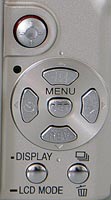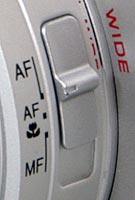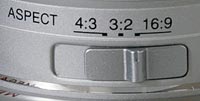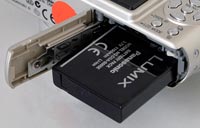Panasonic Lumix DMC-LX2 Review
Review Date: October 10th 2005
Leave a Comment about this Review
|
Ease of Use
The Panasonic DMC-LX2 is a good-looking, understated kind of camera, with a smart silver or black all-metal body. The DMC-LX2 is a fairly compact camera, although it is wide (over 10cms) and, more importantly, it is quite deep. The official specification for the Panasonic Lumix DMC-LX2 claims that the camera is 26.3mm deep, but this doesn't take the lens into account. The true depth of the camera is 45mm, which means that whilst it is still pocketable, it is more of a tight squeeze than the official figures suggest. The Panasonic Lumix DMC-LX2 is perhaps more at home in a small camera bag than in a pocket. It's a well-built camera, with a high quality body and controls. The built-in flash is particularly neat. It pops up out of the top of the body when you open it, and then is stored safely away by pushing it back down. Another feature of the DMC-LX2 that I really liked was the joystick, which allows you to set apertures and shutter speeds and also controls manual focusing. It's an innovative idea that speeds up using the camera, and is something that other manufacturers will hopefully take note of.
Thankfully Panasonic seem to have fixed the very loose lens cap that adversely affected the older DMC-LX1 - you can't pull the cap off the DMC-LX2 without pushing in the plastic handles on the side. The other area of the camera design that slightly concerns me is the large LCD screen, which is slightly raised from the back of the camera. Although there were no obvious problems on my very new review unit, there were a few scratches and scrapes on the older DMC-LX1 that I reviewed last year, which had the same kind of raised screen. They were probably all just issues with what was a review unit that had been well used by other journalists, but it's still worth being careful with the DMC-LX2. One other area to note is that the wider LCD screen of the LX2 has forced Panasonic's designers to move the main controls on the rear of the camera into a smaller space, making it feel a little cramped. The AF/AE Lock button is very close to the area where your right thumb sits when holding the camera, although it is quite hard to accidentally turn it on. This design change is definitely worth paying, though, in return for the larger LCD screen.
| Joystick / Navigation Pad / Display/LCD Mode Button / Self-timer/Delete Button | Focusing Switch |
 |
 |
Despite offering a full range of manual exposure settings, the Panasonic Lumix DMC-LX2 is not an overly complex camera in terms of the number of external controls that it has. I counted 13 in total. This allows the camera to be relatively compact whilst still offering a 4x zoom lens and large 2.8 inch LCD screen. The majority of them are clearly labeled and common to most cameras. There's a traditional dial on the top of the camera that lets you select the different exposure modes; Program, Shutter Priority, Aperture Priority and Manual. This dial is a typical feature of SLR cameras, and enables you to quickly change between the various modes. The various Scene modes and the Movie mode are also accessed via this dial. The most unfamiliar controls are found on the lens barrel. The Focus switch lets you choose between normal auto-focusing, macro and manual focusing. The latter option works quite well, although it is a slow process. The centre of the LCD screen shows a magnified view, with a vertical distance scale on the right. You use the joystick to select a certain distance to achieve sharp focus.
The other control on the lens barrel is the all-important Aspect Ratio switch, which allows you to select the type of image that you want to record. 16:9 is the same as wide-angle televisions and produces a very effective panoramic effect. If you're a fan of cameras like the Hassleblad xPan series, the Panasonic Lumix DMC-LX2's 16:9 mode is quite similar and will definitely appeal to you. All of the camera's 10 megapixel sensor is used in this mode. Panasonic have obviously listened to people who bought the DMC-LX1 and added a 2.8 inch widescreen LCD to the DMC-LX2, which means that the camera no longer blacks out the top and the bottom of the screen to represent the 16:9 and 3:2 views, as on the LX1. 4:3 is the view that the majority of digital cameras offer and records a 7.5 megapixel image, whilst 3:2 is halfway between the two and records a 8.5 megapixel image. This ability to switch between different viewpoints makes the Panasonic Lumix DMC-LX2 a very adaptable and creative tool, especially if you have an interest in panoramic images, and is something that no other camera currently offers.
| Mode Dial / Zoom Lever / Shutter Button / Optical Image Stabilizer Button / On/Off Button | Aspect Ratio Switch |
 |
 |
The main menu system on the Panasonic Lumix DMC-LX2 is straight-forward to use and is accessed by pressing the Menu button in the middle of the navigation pad. There are two main menus, Record and Settings. Quite a lot of the camera's main options, such as white balance, image quality, metering mode and ISO speed, are accessed here, so the Record menu has 16 options spread over 4 screens. Something that I found slightly unintuitive was having to press the right button on the Navigation pad to select an option, rather than the center button as on most cameras. It would also have been good to see the more commonly used options, such as ISO speed, available via the press of a button, rather than having to go into the menu system. Due to the large LCD screen and restricting the number of on-screen choices to five, the various options and icons are very clear and legible.
If you have never used a digital camera before, or you're upgrading from a more basic model, reading the comprehensive and easy-to-follow manual before you start is a must. Thankfully Panasonic have chosen to supply it in printed format, rather than as a PDF on a CD, so you can also carry it with you. The large 2.8 inch LCD screen is the only way of framing your shots, so if you have to have an optical viewfinder, look elsewhere now. Thankfully Panasonic haven't tried to cut costs by limiting the number of pixels - the LCD screen has a generous 207,000 pixels, although this is still the same as the older DMC-LX1. The various icons used to represent the camera settings are clear and legible, although I was slightly annoyed by the LCD Mode message along the bottom of the screen, which is displayed whenever you press the Display button.
There is one innovative feature on the Panasonic Lumix DMC-LX2 that aims to make life easier for you. This camera has an anti-shake system, dubbed Mega O.I.S - turn it on and the Panasonic Lumix DMC-LX2 automatically compensates for camera shake, which is a slight blurring of the image that typically occurs at slow shutter speeds. There are two different modes, Mode 1 is on all the time including image composition, and Mode 2 is only on when you press the shutter button. In practice I found that it does make a noticeable difference, as shown in the examples on the Image Quality page. You don't notice that the camera is actually doing anything different when anti-shake is turned on, just that you can use slower shutter speeds than normal and still take sharp photos. However, what Panasonic gives you in the form of an effective anti-shake system, it takes away by only providing a noise-free ISO range of 100-200 (see the Image Quality page). This essentially means that you really need to leave the anti-shake system turned on all the time to compensate for the slower shutter speeds, which kind of negates any real advantages that the anti-shake system offers. Thankfully leaving the anti-shake system on didn't negatively affect the battery-life, with the camera managing over 275 shots before the battery needed to be recharged.
| Battery Compartment | Memory Card Slot |
 |
 |
The start-up time from turning the Panasonic Lumix DMC-LX2 on to being ready to take a photo is fairly quick at around 1 second, although zooming from the widest focal length to the longest takes a pedestrian 3 seconds. Focusing is very quick in good light and the camera happily achieves focus most of the time indoors or in low-light situations, helped by the focus-assist lamp. Note that the camera does struggle to lock onto the subject sometimes at the tele-photo end of the lens. The visibility and refresh rate of the 2.8 inch LCD screen are perfectly acceptable. It takes about 0.5 second to store a JPEG image, allowing you to keep shooting as they are being recorded onto the memory card - there is no LCD blackout between each image. RAW mode is a completely different kettle of fish. The Panasonic Lumix DMC-LX2 takes around 5 seconds to store a RAW image, during which you can't take another shot or operate the menu system. This is about twice as fast as the older DMC-LX1, but still not exactly lightning quick. In the fastest Continuous mode the camera takes 3 frames per second for up to 3 images at the highest JPEG image quality, which is about average for this class of camera. All in all the Panasonic Lumix DMC-LX2 is average in terms of operational speed.
Once you have captured a photo, the Panasonic Lumix DMC-LX2 has a good range of options when it comes to playing, reviewing and managing your images. You can instantly scroll through the images that you have taken, view thumbnails in different sizes and via a Calendar view, zoom in and out up to 16x magnification, view slideshows with audio, delete, protect, trim, resize and rotate an image. You can also select favourite images, add a sound clip to an image, set the print order and change the aspect ratio after the picture has been taken. The Display button toggles detailed settings information about each picture on and off, such as the ISO rating and aperture / shutter speed, and there is a small histogram available during both shooting and playback. When taking a photo, pressing the Display button toggles between the detailed information, the histogram and gridlines to aid composition.
In summary the Panasonic Lumix DMC-LX2 is a stylish, fairly responsive, well-built camera that offers something different to the norm, and which will particularly appeal to fans of panoramic images, especially now that Panasonic have added a widescreen LCD to match the sensor.
|
 PhotographyBLOG
is a member of the DIWA
organisation. Our test results for the Panasonic Lumix DMC-LX2
have been submitted to DIWA
for comparison with test results for different samples of
the same camera model supplied by other DIWA
member sites.
PhotographyBLOG
is a member of the DIWA
organisation. Our test results for the Panasonic Lumix DMC-LX2
have been submitted to DIWA
for comparison with test results for different samples of
the same camera model supplied by other DIWA
member sites.
